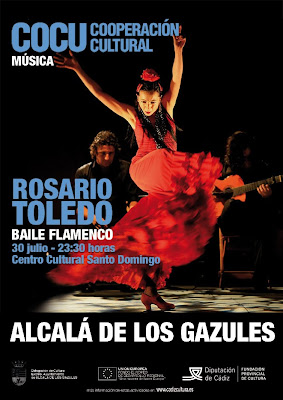Flamenco in Alcalá
We live deep in flamenco territory. You hear it blaring from cars, shops and houses; builders sing it while they are working; I even saw an old boy in a bar late one night, wailing along with whatever he was listening to on his iPod. At the summer ferias women of all ages, shapes and sizes dress up in their flamenco outfits and dance sevillanas. El Camarón de la Isla, probably the most famous flamenco singer or cantaor of all time, lived and died just up the road in San Fernando, or La Isla de Leon as it was once known. (We heard one of his many relatives singing in La Sacristía bar in Alcalá last Christmas, but he was a bit the worse for wear.) A lot of Spanish pop music is influenced by its rhythms and modes, and genres such as flamenquillo and flamenco chill make good listening - check out the bands Chambao or Mártires del Compás.
Traditional flamenco comprises three strands, cante, baile and toque - song, dance and guitar. There are many palos or musical forms, usually involving a highly complex rhythm or compás. This is marked by handclaps or palmas, or if there is a dancer present, by the clack of his or her heels. Occasionally you might see someone beating a hollow wooden box or cajón to mark the rhythm. There are dancers and singers of both sexes, but it is rare to see a female guitarist. I have never seen a dancer using castanets, and I suspect the primary use for these is to sell as souvenirs to tourists.
There are various theories about the roots of flamenco, but it originated in Andalucía and has been influenced by gypsies, Moors and Sephardic Jews along the way. The first recorded use of the term flamenco was not till the late 18th century, and again, the origins of the word are uncertain.
Flamenco guitar-playing and dancing are a major tourist attraction right across Andalucía and this keeps a lot of artists in work. Flamenco singing or cante jondo, however, does not have an instant appeal and although you might get the odd busker in Seville or Jerez you are unlikely to hear it at the tourist venues. Many of the palos are deeply emotional, tragic and intense, and the sound comes from somewhere deep in the heart and guts of the singer - the first word, usually "aayyyyy!" can be drawn out over several bars. It always amazes me that they sing sitting down! The ideal way to appreciate flamenco singing is to hear it live, on a hot sultry night, with the audience calling out their approval (known as jaleo - they usually shout "alé" rather than "olé"). You stand more of a chance if you stop trying to work out what´s going on, and feel rather than listen to it.
To keep the song tradition alive, arts councils, local authorities and flamenco clubs or peñas sponsor singing contests, and three years ago Alcalá started a contest of its own, offering generous cash prizes. The contestants come from all walks of life, and so far have all been male. After the final, a "big name" is booked to draw the crowds; this year it was a dancer from Cádiz called Rosario Toledo, and you can see a video clip of her performance below.
Another opportunity to see top flamenco artists in Alcalá is on the first night of the annual International Music Festival "Al-Kalat" in the middle of August. The rest of the festival is classical. This year´s concert is on Tuesday 10 August and features two up-and-coming young artists: singer Marina Heredia, from Granada, and dancer Moisés Navarro "El Charro" from Málaga, whose publicity photo suggests Michael Jackson has been reincarnated as a bailaor. Watch this space for video clips!
More on the history and forms of flamenco
Glossary of flamenco terms

Comments